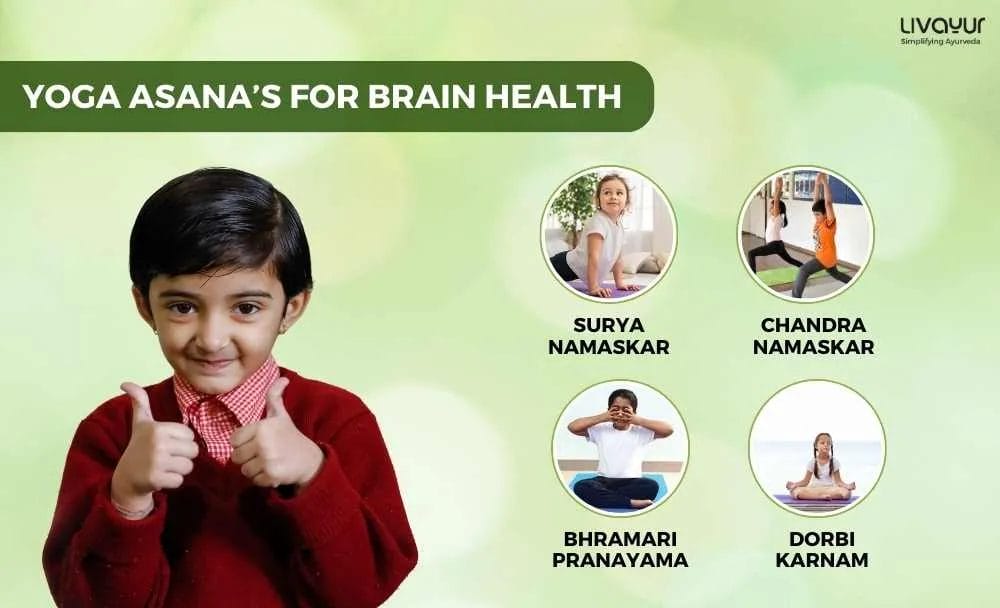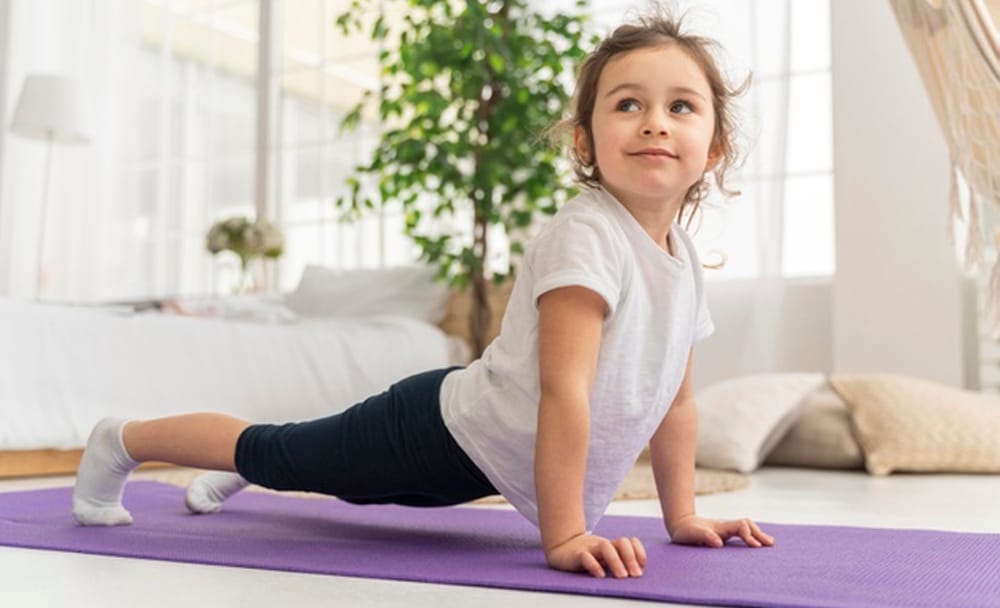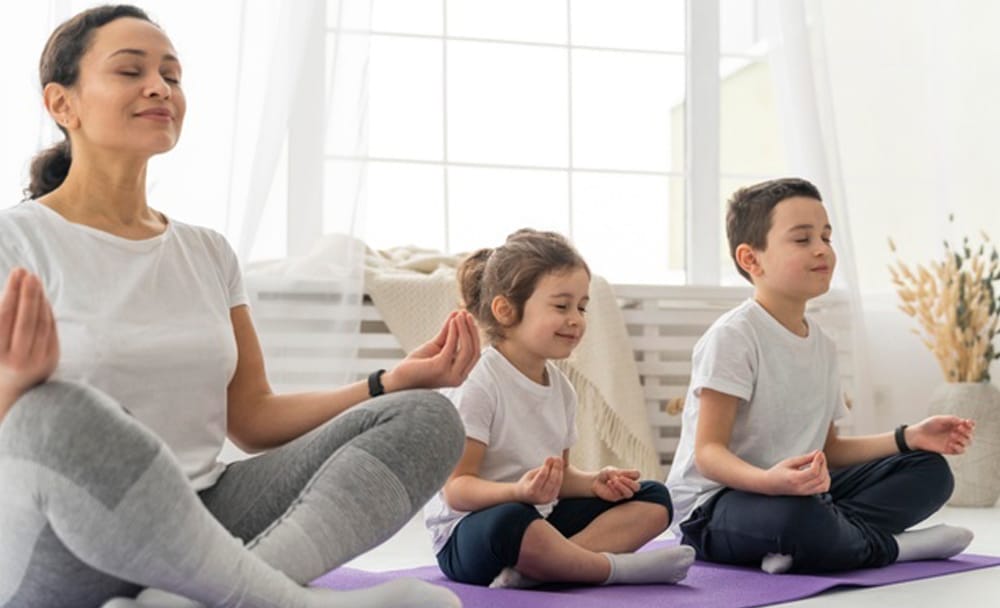Yoga is a healthy ancient practice that can offer long-term positive outcomes for children. Regular practice of Yoga has been known to improve brain functions and boost memory in children. There are many Yoga poses that can help to strengthen children’s brain health, some of which are mentioned in this blog.
Benefits of Yoga for Brain Health of Children
- Yoga helps to improve concentration and memory in children.
- It develops their cognitive skills such as learning and memory, thereby boosting their brain functions.
- Yoga also aids in improving the decision-making abilities of children, thereby helping them perform better at school and other day-to-day activities.
- It also strengthens the parts of the brain responsible for memory retention, awareness, attention, thought and language.
- Yoga helps relieve stress, anxiety and other mental health problems in children, which further help to improve their brain power.
5 Best Yoga Asanas and Pranayama for Children’s Brain Health
Bakasana (Crow Pose):
Bakasana is one of the best Yoga Asanas to boost brainpower in children. It helps strengthen their coordination, improve balance, enhance memory and increase concentration.
How To Do Bakasana?
- Sit in a squat position with your knees kept apart.
- Then, place your palms on the floor, about 6-8 inches in front of your feet. Also, maintain a shoulder-width distance between your palms.
- Next, slightly bend your elbows and touch your upper arm (just below the armpits) with your knees.
- Try to balance your body with your arms and gradually lift your feet off the ground. Make sure your feet are close together.
- Press your arms as straight as possible and focus at a point.
- Stay in this Asana for 5-10 deep breaths, and then gently release the pose.
Surya Namaskar (Sun Salutation):
Surya Namaskar or Sun Salutation helps to improve both the physical and mental health of children. It helps calm their mind, balance energies, reduce anxiety and strengthen their nervous system.
How To Do Surya Namaskar?
Surya Namaskar consists of 12 Asanas. You begin practising the Sun Salutation from the right side of your body and then repeat the same sequence from the left side, completing one full cycle of 24 counts. The sequence of these Asanas is as follows:
- Step 1: Pranamasana (Prayer Pose)
- Step 2: Hasta Uttanasana (Raised Arms Pose)
- Step 3: Hastapadasana (Hand to Foot Pose)
- Step 4: Ashwa Sanchalanasana (Equestrian Pose)
- Step 5: Adho Mukha Svanasana (Downward Facing Dog Pose)
- Step 6: Ashtanga Namaskara (Eight Limbed Pose)
- Step 7: Bhujangasana (Cobra Pose)
- Step 8: Adho Mukha Svanasana (Downward Facing Dog Pose)
- Step 9: Ashwa Sanchalanasana (Equestrian Pose)
- Step 10: Hastapadasana (Hand to Foot Pose)
- Step 11: Hasta Uttanasana (Raised Arms Pose)
- Step 12: Pranamasana (Prayer Pose)
Chandra Namaskar (Moon Salutation):
Chandra Namaskar or Moon Salutation is a sequence of various Yoga poses that help to nourish the body, mind and spirit. It is practised during the evenings and uses the lunar energy to affect the frequencies of the mind responsible for feelings, emotions and desires.
How To Do Chandra Namaskar?
Chandra Namaskar consists of 14 Asanas, the sequence of which is given below. You must start Chandra Namaskar from the left side of your body and then repeat the same sequence from the right side, completing one cycle of Moon Salutation of 28 counts.
- Step 1: Pranamasana (Prayer Pose)
- Step 2: Hasta Uttanasana (Raised Arms Pose)
- Step 3: Padahastasana (Hand to Foot Pose)
- Step 4: Ashwa Sanchalanasana (Equestrian Pose)
- Step 5: Ardha Chandrasana (Half Moon Pose)
- Step 6: Parvatasana (Mountain Pose)
- Step 7: Ashtanga Namaskara (Eight Limbed Pose)
- Step 8: Bhujangasana (Cobra Pose)
- Step 9: Parvatasana (Mountain Pose)
- Step 10: Ashwa Sanchalanasana (Equestrian Pose)
- Step 11: Ardha Chandrasana (Half Moon Pose)
- Step 12: Padahastasana (Hand to Foot Pose)
- Step 13: Hasta Uttanasana (Raised Arms Pose)
- Step 14: Pranamasana (Prayer Pose)
Super Brain Yoga:
Super Brain Yoga or Dorbi Karnam technique is a form of Yoga that involves acupressure and breathing techniques to balance the energies in both hemispheres of the brain. It helps to improve attention, stimulate cognitive skills, enhance creativity, boost decision-making powers and calm the nerves of the mind. It is one of the best Yoga poses to improve memory in children and treat disorders like ADHD, autism, dyslexia etc.
How To Do Super Brain Yoga?
- Stand straight and place your arms alongside.
- Then, lift your left arm and hold your right earlobe while holding the left earlobe with your right arm. Use your index finger and thumb to hold the earlobes, with your thumb placed in front of the ears.
- Next, exhale slowly and come down to a squatting position.
- Stay in this pose for a few seconds and then inhale as you gently release the pose.
- Repeat this Yoga a few times.
Bhramari Pranayama (Bumblebee Breath):
Bhramari Pranayama is a breathing exercise that helps to improve memory and concentration in children while also relieving negative emotions from the mind such as anger, frustration, anxiety, etc.
How To Do Bhramari Pranayama?
- Sit straight in a quiet and comfortable place with your eyes closed. Try to meditate and observe the various sensations in your body.
- Then, place your index finger on your ears right at the cartilage.
- Slightly press your cartilage and take deep breaths as you make a humming sound like a bee. It is recommended to make high-pitched sounds for better results.
- To release the pose, gradually open your eyes and become aware of your surroundings.
- Repeat this Pranayama 3-4 times.
Takeaway
Yoga is one of the best ways to improve brain health in children. Ask your kids to practice the Yoga Asanas mentioned above every day to boost their brainpower and memory.






















